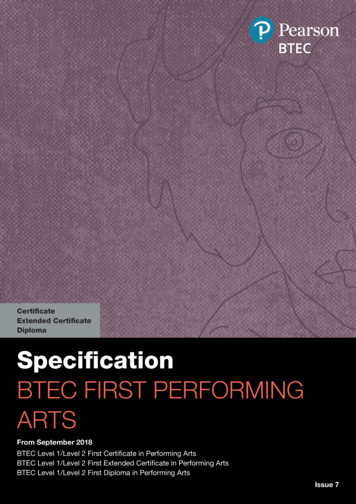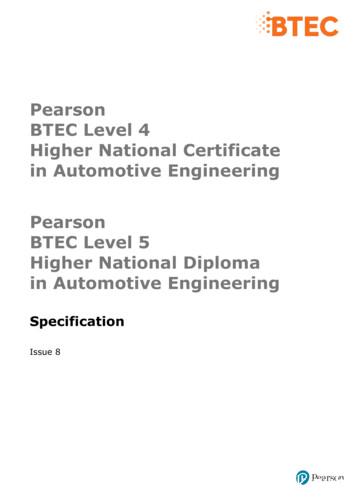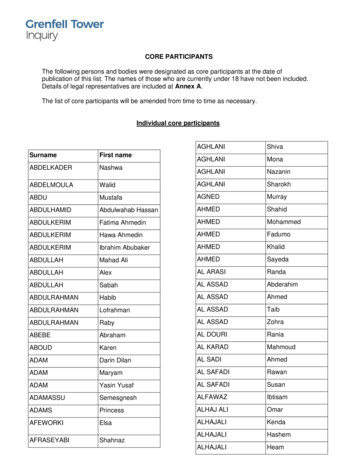BTEC FIRST PERFORMING ARTS - Pearson Qualifications
CertificateExtended CertificateDiplomaSpecificationBTEC FIRST PERFORMINGARTSFrom September 2018BTEC Level 1/Level 2 First Certificate in Performing ArtsBTEC Level 1/Level 2 First Extended Certificate in Performing ArtsBTEC Level 1/Level 2 First Diploma in Performing ArtsIssue 7
PearsonBTEC Level 1/Level 2First Certificatein Performing ArtsPearsonBTEC Level 1/Level 2First Extended Certificatein Performing ArtsPearsonBTEC Level 1/Level 2First Diploma inPerforming ArtsSpecificationFirst teaching September 2018Issue 7
Edexcel, BTEC and LCCI qualificationsEdexcel, BTEC and LCCI qualifications are awarded by Pearson, the UK’s largestawarding body offering academic and vocational qualifications that are globallyrecognised and benchmarked. For further information, please visit our qualificationswebsite at qualifications.pearson.com. Alternatively, you can get in touch with ususing the details on our contact us page at qualifications.pearson.com/contactusAbout PearsonPearson is the world's leading learning company, with 25,000 employees in more than70 countries working to help people of all ages to make measurable progress in theirlives through learning. We put the learner at the centre of everything we do, becausewherever learning flourishes, so do people. Find out more about how we can help youand your learners at qualifications.pearson.comThis specification is Issue 7. We will inform centres of any changes to this issue.The latest issue can be found on our website.References to third-party material made in this specification are made in good faith.We do not endorse, approve or accept responsibility for the content of materials,which may be subject to change, or any opinions expressed therein. (Material mayinclude textbooks, journals, magazines and other publications and websites.)All information in this specification is correct at time of publication.ISBN 978 1 446 93635 1All the material in this publication is copyright Pearson Education Limited 2020
Summary of Pearson BTEC Level 1/Level 2 Certificate, Extended Certificate andDiploma in Performing Arts Issue 7 changesSummary of changes made between previous issue and thiscurrent issuePage/sectionnumberTQT for the Certificate has changed to 320.Page 6TQT for the Extended Certificate has changed to 480.TQT for the Diploma has changed to 640.Summary of changes made between Issue 4 and Issue 6Page/sectionnumberTeacher observation has been removed throughout the specification.ThroughoutThe wording in Section 8 Internal assessment subsection Dealing withmalpractice has been updated to clarify suspension of certification incertain circumstances.Page 58Section 10 Awarding and reporting the qualificationsPage 66The wording under Calculation of qualification change has beenupdated.The wording under Section 10 Awarding and reporting for thequalifications subsection Calculation of the qualification grade has beenupdated to clarify current practice in ensuring maintenance andconsistency of qualification standards.Pages 69-70Unit 2: Preparation, Performance and ProductionPages 86Learning aim A: Take part in the preparations for a live performance ‘Learners will take part in activities that explore and develop’updated to ‘Learners will take part in activities to research, exploreand develop’ ‘explore’ updated to ‘explore and research’Unit 3: Acting SkillsAssessment guidance ‘sessions supported by teacher observations.’ removed from thecontent ‘Evidence should be in the form of a recording of the performance,’updated to ‘Evidence should be in the form of video recordings ofmilestone rehearsals and the final performance’Suggested assignment outlines ‘Teacher observations.’ removed from the assessment evidencePages 104, 106
Summary of changes made between Issue 4 and Issue 6Page/sectionnumberUnit 4: Dance SkillsPages 114, 116Assessment guidance ‘exercises and this should be supported by teacher observationsand/or witness statements.’ removed from the content ‘Learning aim B could be evidenced through a written report,audio/video recording of the performance (a one-minute technicalsequence) or viva voce examination.’ updated to ‘Learning aim Bshould be evidenced through video recordings of rehearsals and thefinal performance.’Suggested assignment outlines ‘Teacher observations.’ removed from the assessment evidence ‘Witness statements.’ removed from the assessment evidenceUnit 5: Musical Theatre SkillsPages 123, 126Assessment guidance ‘which should be supported by teacher observation.’ removed fromthe contentSuggested assignment outlines ‘Teacher observations.’ removed from the assessment evidenceUnit 6: Music Performance SkillsPage 134, 136Assessment guidance ‘sessions supported by teacher observation records.’ RemovedSuggested assignment outlines ‘Teacher observations.’ removed from the assessment evidenceUnit 7: Production Skills for PerformancePage 145Teacher guidanceAssessment guidance ‘Teacher observation reports.’ updated to ‘Teacher observationreports if necessary’Unit 10: Movement SkillsPages 169, 171Assessment Guidance‘Teacher observations and/or witness statements can be used assupporting evidence for all criteria in this unit’ has been removed.Suggested assignment outlinesAssessment evidence‘Teacher observations’ has been removed.Unit 11: Devising Performance WorkAssessment Guidance6th paragraph ‘Much of this evidence will be in the form of teacherobservation statements, supported by video or photographic evidenceof selected classes, workshops or rehearsals’ has been removed.Suggested assignment outlinesAssessment evidence‘Teacher observations’ has been removed.Pages 178, 180
Summary of changes made between Issue 4 and Issue 6Page/sectionnumberUnit 12: Exploring ImprovisationPages 187, 189Assessment Guidance‘Teacher observations’ has been removed.Suggested assignment outlinesAssessment evidence‘Teacher’ has been removed.Unit 13: Multimedia PerformancePages 197, 199Assessment Guidance‘Teacher observations’ has been removed.Suggested assignment outlinesAssessment evidence‘Teacher’ has been removed.Unit 14: Voice and Speech for PerformersPages 207, 208Assessment Guidance‘Teacher observations’ has been removed.Suggested assignment outlinesAssessment evidence‘Teacher’ has been removed.Unit 15: Performing Scripted PlaysPage 217, 219Assessment Guidance has been reworded for Learning Aim A andLearning Aim B.Suggested assignment outlinesAssessment evidence‘Teacher observations’ has been removed.Unit 16: Contemporary Dance TechniquesPages 227, 229Assessment Guidance‘Teacher observations and learner records such as logbooks’ has beenremoved.Suggested assignment outlinesAssessment evidence‘Teacher’ has been removed.Unit 17: Exploring Urban DancePage 238Assessment Guidance3rd paragraph – reworded and updated.Unit 18: Jazz Dance TechniquesPage 246Assessment Guidance2nd paragraph – reworded and updated.Unit 20: Realising Costume Design for PerformanceAssessment GuidanceLearning Aim A and B have been reworded and updated.Page 262
Summary of changes made between Issue 4 and Issue 6Page/sectionnumberUnit 22: Realising Prop Design for PerformancePage 277Assessment Guidance2nd and 3rd Paragraph – reworded and updated.Unit 23: Realising Mask Design for PerformancePage 286Assessment Guidance3rd and 4th Paragraph – reworded and updated.Unit 24: Lighting for PerformancePage 295Assessment Guidance2nd Paragraph – reworded and updated.Unit 25: Sound for PerformancePage 305Assessment Guidance2nd Paragraph – reworded and updated.If you need further information on these changes or what they mean, please contact usvia our website at: qualifications.pearson.com.
Welcome to your BTEC First specificationFor more than 25 years, BTECs have earned their reputation as well-established,enduringly effective qualifications. They have a proven track record in improvingmotivation and achievement among young learners. Additionally, BTECs provideprogression routes to the next stage of education or to employment.What are the key principles of the BTEC Firsts?To support young people to succeed and progress in their education, we have drawn onour consultation and embedded four key design principles into the BTEC Firsts.1 Standards: a common core and external assessmentEach Level 2 BTEC First qualification has an essential core of knowledge and appliedskills. We have introduced external assessment appropriate to the sector. This providesindependent evidence of learning and progression alongside the predominantlyportfolio-based assessment.2 Quality: a robust quality-assurance modelBuilding on strong foundations, we have further developed our quality-assurance modelto ensure robust support for learners, centres and assessors.We will make sure that: every BTEC learner’s work is independently scrutinised through the externalassessment process every BTEC assessor will take part in a sampling and quality review during theteaching cycle we visit each BTEC centre every year to review and support your quality processes.We believe this combination of rigour, dialogue and support will underpin the validityof the teacher-led assessment and the learner-centric approach that lie at the heart ofBTEC learning.3 Breadth and progression: a range of options building on the mandatory units,contextualised English and mathematicsThe mandatory units assess knowledge, understanding and skills that are essentialto the curriculum area or vocational industry. These mandatory units ensure that alllearners receive a thorough grounding in the sector to support progression to theirnext stage in education or employment.The optional specialist units provide a closer focus on a vocational area, supportingprogression to a more specialised Level 3 vocational or academic course or to anApprenticeship.Opportunities to develop skills in English and mathematics are indicated in the unitswhere appropriate. These give learners the opportunity to practise these essential skillsin naturally occurring and meaningful contexts, where appropriate to the sector.
4 Recognising achievement: opportunity to achieve at Level 1The BTEC Firsts will continue to provide for the needs of learners who are aiming toachieve a Level 2 qualification. However, we have recognised that for some learnersachieving this standard in all units in one to two years may not be possible. Therefore,the qualifications have been designed as Level 1/Level 2 qualifications with gradesavailable at Level 2 and at Level 1 Pass.Improved specification and supportIn our consultation, we also asked about what kind of guidance you, as teachers andtutors, need. As a result, we have streamlined the specification to make the units easierto navigate, and we provide enhanced support in the accompanying Delivery Guide.Thank youFinally, we would like to extend our thanks to everyone who provided support andfeedback during the development of the new BTEC Firsts, particularly all of you whohelped to shape these new qualifications. We hope you enjoy teaching the course.
ContentsPurpose of this specification1Qualification titles and Qualification Numbers21 What are BTEC Firsts?32 Key features of the BTEC First suite of qualifications53 Pearson BTEC Level 1/Level 2 First Certificate, Extended Certificateand Diploma in Performing Arts11Rationale for the Pearson BTEC Level 1/Level 2 First Certificate, ExtendedCertificate and Diploma in Performing Arts114 Qualification structures18Qualification structure for the Pearson BTEC Level 1/Level 2 First Certificate inPerforming Arts (Acting)19Qualification structure for the Pearson BTEC Level 1/Level 2 First Certificate inPerforming Arts (Dance)21Qualification structure for the Pearson BTEC Level 1/Level 2 First Certificate inPerforming Arts (Musical Theatre)23Qualification structure for the Pearson BTEC Level 1/Level 2 First Certificate inPerforming Arts (Production)25Qualification structure for the Pearson BTEC Level 1/Level 2 First ExtendedCertificate in Performing Arts27Qualification structure for the Pearson BTEC Level 1/Level 2 First ExtendedCertificate in Performing Arts (Acting)29Qualification structure for the Pearson BTEC Level 1/Level 2 First ExtendedCertificate in Performing Arts (Dance)31Qualification structure for the Pearson BTEC Level 1/Level 2 First ExtendedCertificate in Performing Arts (Production)33Qualification structure of the Pearson BTEC Level 1/Level 2 First Diploma inPerforming Arts35Qualification structure of the Pearson BTEC Level 1/Level 2 First Diploma inPerforming Arts (Acting)37Qualification structure of the Pearson BTEC Level 1/Level 2 First Diploma inPerforming Arts (Dance)39Qualification structure of the Pearson BTEC Level 1/Level 2 First Diploma inPerforming Arts (Production)415 Programme delivery43Resources43Delivery approach44Personal, learning and thinking skills44English and mathematics knowledge and skills44Functional Skills at Level 2456 Access and recruitment46Prior knowledge, skills and understanding46Access to qualifications for learners with disabilities or specific needs47Special consideration47
7 The layout of units in the specification488 Internal assessment51Language of assessment51Summary of internal assessment51Assessment and verification roles51Learner preparation53Designing assessment instruments53Authenticity and authentication55Applying criteria to internal assessments55Assessment decisions56Late submission57Resubmission of improved evidence57Appeals58Dealing with malpractice58Reasonable adjustments to assessment58Special consideration589 External assessment60Requirements for the implementation of controlled conditions for Unit 1:Individual Showcase61Grade descriptors for the internal and external units6310 Awarding and reporting for the qualifications6611 Quality assurance of centres7312 Further information and useful publications7413 Professional development and support75Units77Unit 1: Individual Showcase79Unit 2: Preparation, Performance and Production85Unit 3: Acting Skills97Unit 4: Dance Skills107Unit 5: Musical Theatre Skills117Unit 6: Music Performance Skills127Unit 7: Production Skills for Performance137Unit 8: The Performing Arts Industry149Unit 9: Performance in Context157Unit 10: Movement Skills165Unit 11: Devising Performance Work173Unit 12: Exploring Improvisation181Unit 13: Multimedia Performance191Unit 14: Voice and Speech for Performers201Unit 15: Performing Scripted Plays211Unit 16: Contemporary Dance Techniques221Unit 17: Exploring Urban Dance Styles231Unit 18: Jazz Dance Techniques241
Unit 19: Design Planning for Performance249Unit 20: Realising Costume Design for Performance257Unit 21: Realising Set Design for Performance265Unit 22: Realising Prop Design for Performance273Unit 23: Realising Mask Design for Performance281Unit 24: Lighting for Performance289Unit 25: Sound for Performance299Unit 26: Supporting Performance: Stage Management309Unit 27: Supporting Performance: Front of House317Unit 28: Make-up for Performance325Unit 29: Wardrobe for Stage Performance335Unit 30: Choreographing Dance345Unit 31: Community Arts355Unit 32: Directing Performance367Unit 33: Planning and Managing a Performing Arts Event381Unit 34: Multimedia Production393Unit 35: Physical Theatre Performance405Unit 36: Variety Performance417Unit 37: Performing Arts Enterprise427Unit 38: Use of ICT in the Performing Arts437Unit 39: Work Experience in the Performing Arts447Unit 40: Singing Skills in the Performing Arts459Annexe APersonal, learning and thinking skillsAnnexe BLevel 2 Functional SkillsAnnexe CSynoptic assessmentAnnexe DDefinitions of terms used in assessment criteria grids for the internal unitsAnnexe ESummary of units in the BTEC Level 1/Level 2 First in Performing ArtsAnnexe FStructure: Pearson BTEC Level 1/Level 2 First Award in Performing Arts471471477477483483485485489489493493
INTRODUCTIONPurpose of this specificationThe purpose of this specification, as defined by Ofqual, is to set out: the objectives of each qualification in the suite any other qualification that a learner must complete before taking a qualification any prior knowledge, skills or understanding that the learner is required to havebefore taking the qualifications units that a learner must complete before a qualification can be awarded,and any optional routes any other requirements that a learner must have satisfied before they can beassessed, or before a qualification can be awarded the knowledge, skills and understanding that will be assessed as part of thequalifications (giving a clear indication of their coverage and depth) the method of any assessment and any associated requirements relating to it the criteria against which learners’ level of attainment will be measured(such as assessment criteria) any specimen materials (supplied separately) any specified levels of attainment.Pearson BTEC Level 1/Level 2 First Certificate, Extended Certificate and Diploma in Performing Arts –Issue 7 – August 2020 Pearson Education Limited 20201
INTRODUCTIONQualification titles andQualification NumbersQualificationtitlePearson BTEC Level 1/Level 2 First Certificate in PerformingArtsQualificationNumber (QN)600/6869/3QualificationtitlePearson BTEC Level 1/Level 2 First Extended Certificate inPerforming ArtsQualificationNumber (QN)600/6870/XQualificationtitlePearson BTEC Level 1/Level 2 First Diploma in PerformingArtsQualificationNumber (QN)601/0168/4These qualifications are on the Regulated Qualifications Framework (RQF).Your centre should use the Qualification Number (QN) when seeking funding foryour learners.The qualification title, units and QN will appear on each learner’s final certificate.You should tell your learners this when your centre recruits them and registers them withus. Further information on certification is in our UK Information Manual, available on ourwebsite: qualifications.pearson.com2Pearson BTEC Level 1/Level 2 First Certificate, Extended Certificate and Diploma in Performing Arts –Issue 7 – August 2020 Pearson Education Limited 2020
INTRODUCTION1 What are BTEC Firsts?BTEC First qualifications were originally designed for use in colleges, schools andthe workplace as an introductory Level 2 course for learners wanting to studyin the context of a vocational sector. This is still relevant today. The knowledge,understanding and skills learned in studying a BTEC First will aid progression to furtherstudy and prepare learners to enter the workplace in due course. In the Performing Artssector, typical employment opportunities may include working as a performer in theatre,film, television or radio, or working in stage management or theatre administration as atheatre designer or technician.These qualifications are intended primarily for learners in the 14–19 age group,but they may also be used by other learners who wish to gain an introductoryunderstanding of a vocational area. When taken as part of a balanced curriculum,there is a clear progression route to a Level 3 course or an Apprenticeship.BTECs are vocationally-related qualifications, where learners develop knowledgeand understanding by applying their learning and skills in a work-related context.Additionally, they are popular and effective because they engage learners to takeresponsibility for their own learning and to develop skills that are essential for themodern-day workplace. These skills include: teamworking; working from a prescribedbrief; working to deadlines; presenting information effectively; and accurately completingadministrative tasks and processes. BTEC Firsts motivate learners and open doors toprogression to further study and responsibility in the workplace.The BTEC First suite of qualificationsThe following qualifications are part of the BTEC First suite: Application of Science Applied Science Art and Design Business Children’s Play, Learning and Development Construction and the Built Environment Creative Digital Media Production Engineering Health and Social Care Hospi
Performing Arts 35 Qualification structure of the Pearson BTEC Level 1/Level 2 First Diploma in Performing Arts (Acting) 37 Qualification structure of the Pearson BTEC Level 1/Level 2 First Diploma in Performing Arts (Dance) 39 Qualification structure of the Pearson BTEC Level 1/Level 2 First Diploma in Performing Arts (Production) 41
Pearson BTEC Level 4 HNC The Pearson BTEC Level 4 HNC in Business is a qualification with a minimum of 120 credits of which 60 are mandatory core. The Pearson BTEC Level 4 HNC programme must contain a minimum of 65 credits at level 4. Pearson BTEC Level 5 HND The Pearson BTEC Lev
Technology Pearson BTEC Level 3 National Foundation Diploma in Information Technology First teaching 2016 Pearson BTEC Level 3 National Diploma (2017) in Information Technology Pearson BTEC Level 3 National Extended Diploma (2017) in Information Technology First teaching 2017 . Edexcel, BTEC and LCCI qualifications Edexcel, BTEC and LCCI qualifications are awarded by Pearson, the UK’s .
Pearson BTEC Level 3 National Diploma in Performing Arts (720 GLH) 601/723 2/0 Pearson BTEC Level 3 National Extended Diploma in Performing Arts (1080 GLH) 601/7234 /4. Some BTEC National qualifications are for post- 16 learners who want to specialise in a specific
Qualification sizes for BTEC Firsts in the Performing Arts sector 6 3 Pearson BTEC Level 1/Level 2 First Award in Performing Arts 9 Rationale for the Pearson BTEC Level 1/Level 2 First Award in Performing Arts 9 4 Qualification structure 11 5 Programme delivery 12 Resources 12 Delivery approach 13 Personal, learning and thinking skills 13
Qualification sizes for BTEC Firsts in the Business sector 6 3 Pearson BTEC Level 1/Level 2 First Diploma in Business 9 Rationale for the Pearson BTEC Level 1/Level 2 First Diploma in Business 9 4 Qualification structure 14 Qualification structure of the Pearson BTEC Level 1/Level 2 First Diplom
BTEC Level 4 HNC The Pearson BTEC Level 4 HNC in Business (QCF) is a qualification with a minimum of 120 credits of which 60 are mandatory core. The BTEC Level 4 HNC programme must contain a minimum of 65 credits at level 4. BTEC Level 5 HND The Pearson BTEC Level 5 HND in Business (QCF) is a qualification with a
Pearson BTEC Level 4 HNC Diploma in Automotive Engineering Pearson BTEC Level 5 HND Diploma in Automotive Engineering The BTEC HNCs (Higher National Certificates) are now at level 4 and are a minimum of 120 credits in size. They have been nested within the structures of the BTEC HNDs (Higher National Diplomas). BTEC HNDs are level 5 qualifications.
GHAMI Asia HARRIS GHAVIMI HARTLEYClarita GIL Maria GIRMA Turufat GOMES Marcio GOMEZ Luis GOMEZ Jessica GOMEZ Marie GOTTARDI Giannino GORDON Natasha GREAVES Cynthia GREENWOOD Peter GRIFFIN Daniel HABIB Assema Kedir HABIB Fatuma Kedir HABIB Jemal Kedir HABIB Merema Kedir HABIB Mehammed Kedir HABIB Mojda HABIB Shemsu Kedir HADDADI Rkia HADGAY Ismal HAKIM Hamid HAKIM Mohamed HAMDAN Rkia HAMDAN .























